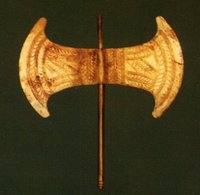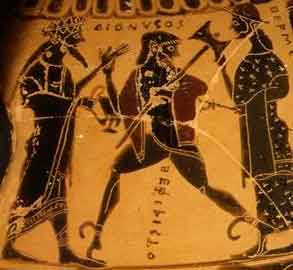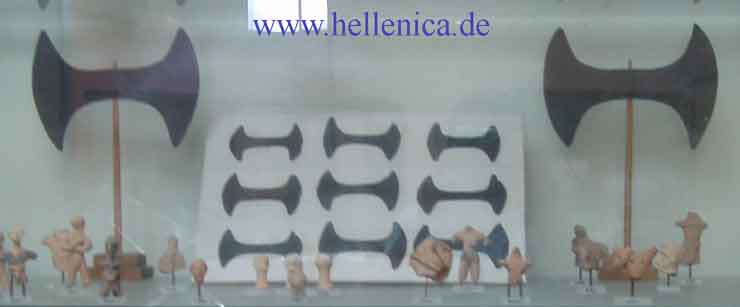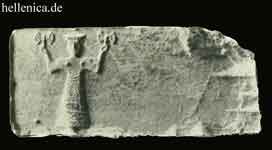.

Minoan symbolic labrys of gold, 2nd millennium BC: many have been found in the sacred cave of Arkalochori on Crete)
The Labrys is the doubleheaded axe, known to the Classical Greeks as pelekus (πέλεκυς [1] )but which predated the arrival of the Hellenes in the Aegean world. Representations of the labrys are on Neolithic finds of "Old Europe", and the labrys is continued in Minoan Thracian, Greek (and Byzantine) art and mythology. It also appears in African mythology (see Shango). Today, it is sometimes used as a symbol associated with female and matristic power.
Etymology
In English the first appearance of "labrys" is reported in OED from Journal of Hellenic Studies XXI. 108 (1901): "It seems natural to interpret names of Carian sanctuaries like Labranda in the most literal sense as the place of the sacred labrys, which was the Lydian (or Carian) name for the Greek πέλεκυς, or double-edged axe." And, p. 109, "On Carian coins indeed of quite late date the labrys, set up on its long pillar-like handle, with two dependent fillets, has much the appearance of a cult image."
The non-Greek word "labrys" first appears in Plutarch as the Lydian word for axe (Greek Questions, xlv):
Herakles, having slain Hippolyte and taken her axe with the rest of her arms, gave it to Omphale. The kings of Lydia who succeeded her carried this as one of their sacred insignia of office, and passed it down from father to son until Candaules. Candaules, however, disdained it and gave it to one of his companions to carry. When Gyges rebelled and was making war upon Candaules, Arselis came with a force from Mylasa to the assistance of Gyges, slew Candaules and his companion, and took the axe to Caria with the other spoils of war. And having set up a statue of Zeus, he put the axe in his hand and called the god, "Labrandeus," labrys being the Lydian word for 'axe'. (Λυδοὶ γάρ ‘λάβρυν’ τὸν πέλεκυν ὀνομάζουσι 2.302a.) [2]
Archeology suggests that the veneration of Zeus Labraundeos at Labraunda was far older than Plutarch imagined. Like its apparent cognate "labyrinth", the word entered the Greek language as a loanword, so that its etymology, and even its original language, is not positively known. The loanword labyrinth was used in Greek, but the designation "The house of the Double Axe" for the palace at Knossos is an imaginative modern innovation.
Minoan civilization
The term, and the symbol, is most closely associated with the Minoan civilization, which reached its peak in the 2nd millennium BC. Some Minoan labrys have been found which are taller than a man and which might have been used during sacrifices. The sacrifices would likely have been of bulls. In feminist interpretations (particularly by Marija Gimbutas), it is also interpreted as a symbol of the Mother Goddess and compared to the shape of a butterfly rather than an axe.
Ancient Greece
The word labyrinthos (Mycenaean daburintos [3]) is probably connected with the word labrys. In the context of the myth of Theseus, the labyrinth of Greek mythology is frequently associated with the Minoan palace of Knossos.

Hephaestus with a Labrys , Berlin F1704 detail
On Greek vase paintings, a labrys sometimes appears in scenes of animal sacrifice, particularly as a weapon for the slaying of bulls. On the "Perseus Vase" in Berlin (F1704; ca 570–560 BC), Hephaestus ritually flees his act of slicing open the head of Zeus to free Athena: over his shoulder is the instrument he has used, the double-headed axe. (The more usual double-headed instrument of Hephaestus is the double-headed smith's hammer.) On Greek coins of the classical period (e.g. Pixodauros, etc.) a type of Zeus venerated at Labraunda in Caria that numismatists call Zeus Labraundeus stands with a tall lotus-tipped sceptre upright in his left hand and the double-headed axe over his right shoulder. The double-axe also appears in Thracian art. On the Aleksandrovo kurgan fresco, it is probably wielded by Zalmoxis.

Labrys, Archaeological Museum, Herakleion

Small Labrys examples , Archaeological Museum Heakleion


Double Axe Relief, Siteia , Double Axe Relief, Siteia ,
Popular culture
Today, probably influenced by traditions that link the Amazons with the battle-axe (see Sagaris), the labrys is sometimes used as a symbol of female empowerment, signifying lesbianism in particular, and appearing in Wiccan ritual.
See also
Sagaris
Axe (tool)
Battle-axe
Francisca
Fasces
Notes
- the term for a single-bladed axe being hēmipelekus "half-pelekus", e.g. Il. 23.883.
- Λυδοὶ γάρ ‘λάβρυν’ τὸν πέλεκυν ὀνομάζουσι 2.302a.
- da-pu2-ri-to-yo (KN Gg 702), daburinthoyo potnia meaning "Lady of the Labyrinth".
| Ancient Greece
Science, Technology , Medicine , Warfare, , Biographies , Life , Cities/Places/Maps , Arts , Literature , Philosophy ,Olympics, Mythology , History , Images Medieval Greece / Byzantine Empire Science, Technology, Arts, , Warfare , Literature, Biographies, Icons, History Modern Greece Cities, Islands, Regions, Fauna/Flora ,Biographies , History , Warfare, Science/Technology, Literature, Music , Arts , Film/Actors , Sport , Fashion --- |
Retrieved from "http://en.wikipedia.org/"
All text is available under the terms of the GNU Free Documentation License

